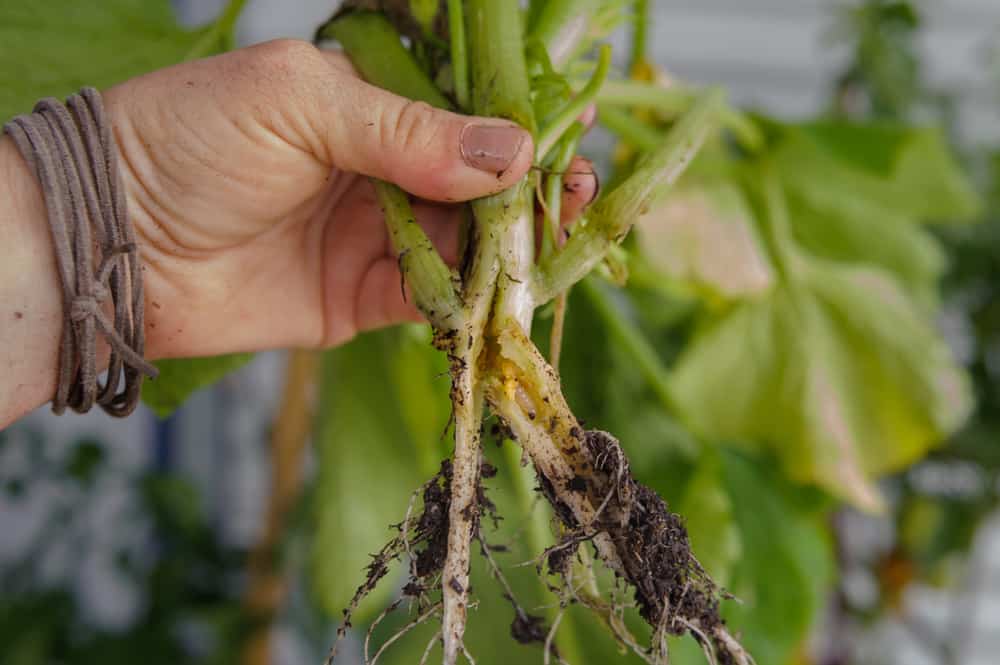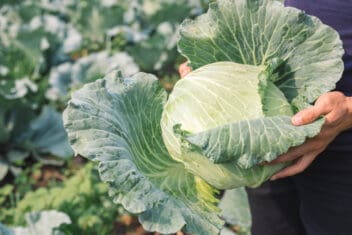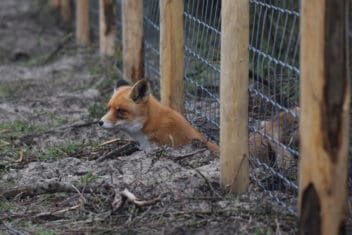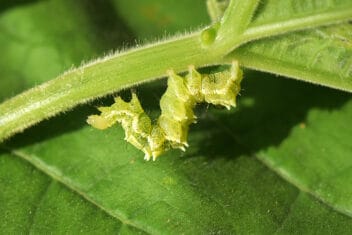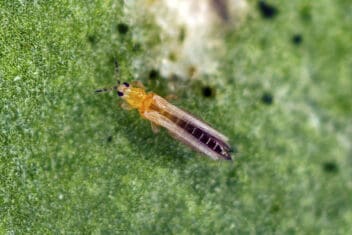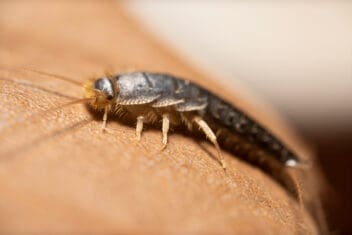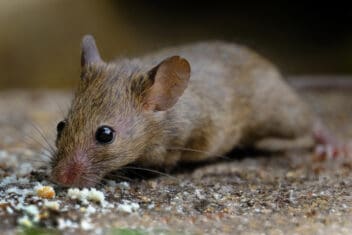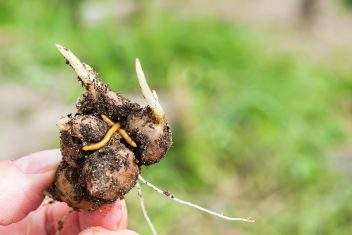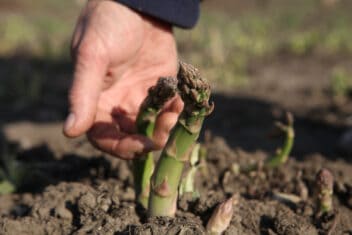This was an epic year for squashes in our garden. A friend gave us heirloom ‘Long Pie’ pumpkin seeds, we had volunteer butternut and round pie pumpkins in abundance. Deep in the south, my sister’s harvest was less successful. She found squash vine borers on her pumpkin vines early in the growing season.
By the end of July, her squashes were dead – first wilting, then collapsing into a mushy mess.
Squash vine borers attack across the US and they can destroy an entire harvest pretty quickly, so knowing how to identify and stop them is essential.
Meet the Squash Vine Borer
If your garden is full of squashes, it’s likely you’ve met this little pest before. When squash vine borers come to town the harvest is usually disappointing. Squash borers (Melittia cucurbitae) can turn a lush pumpkin patch into a wilting pile of broken dreams overnight. If you don’t catch them soon enough, they can even destroy an entire harvest.
Then they’ll move on to eating cucumbers and melons!
Left to their own devices, these wicked-looking insects can wipe out half a garden before burrowing in the ground to await next year’s produce.
Recognizing the Enemy
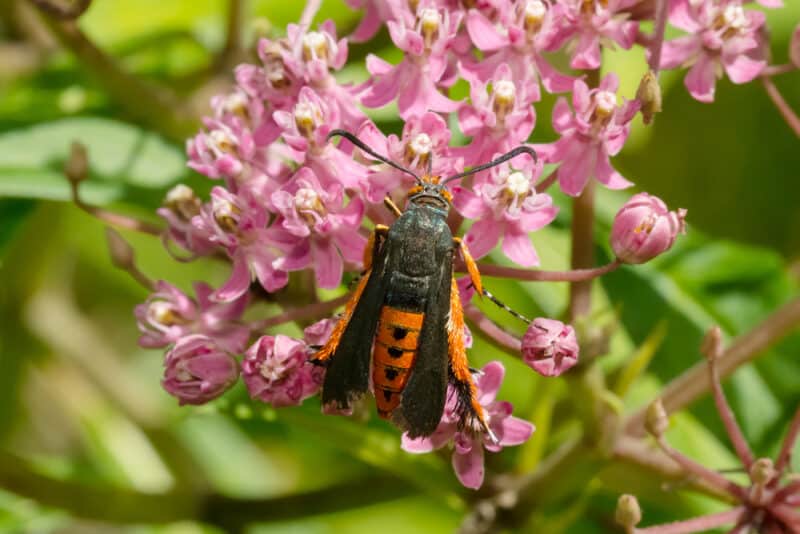
Adult squash vine borers look waspish. They have reddish-orange and black, scaly bodies and translucent black wings. They also have an upper pair of metallic green wings. Adult borers are about 1/2 inch long.
Despite looking like wasps squash borers are actually moths. They belong to the sesiid family of moths and are native to North America. Squash borers tend to live in the more temperate states. They love the deep south. In fact, southern squash borers can produce two broods each year instead of the one brood produced in the north.
Northern, less temperate climates can host squash borers, but they don’t thrive above zone 6. That’s good news for those of us in the frozen tundra. Unfortunately, it leaves most gardens are very much at risk.
The Life Cycle of A Squash Vine Borer
Adult squash borers lay small clusters of reddish eggs on squash leaves. Usually, they lay their eggs on the underside of the leaves to protect them from birds, other insects, and you. After about a week, the eggs hatch – and that’s when the trouble really begins.
Newly hatched squash vine borers fall from to the ground, crawl directly to the nearest squash stem, and bore into it. Then they feed. These little caterpillars can eat their way through squash vines for up to 6 weeks before burrowing into the ground to pupate.
In the deep south, they may emerge as adults before the growing season is over. But in most of North America, adult squash vine borers emerge in the spring to lay their eggs on leaves and start the cycle all over again.
Affected Plants
Squash vine borers affect all squashes, but they especially love pumpkins, hubbards, and zucchini. Squash borers will occasionally attack cucumber and melon plants if they’re close at hand. If you have a squash borer infestation, check all your susceptible plants often for signs of damage.
The Larvae
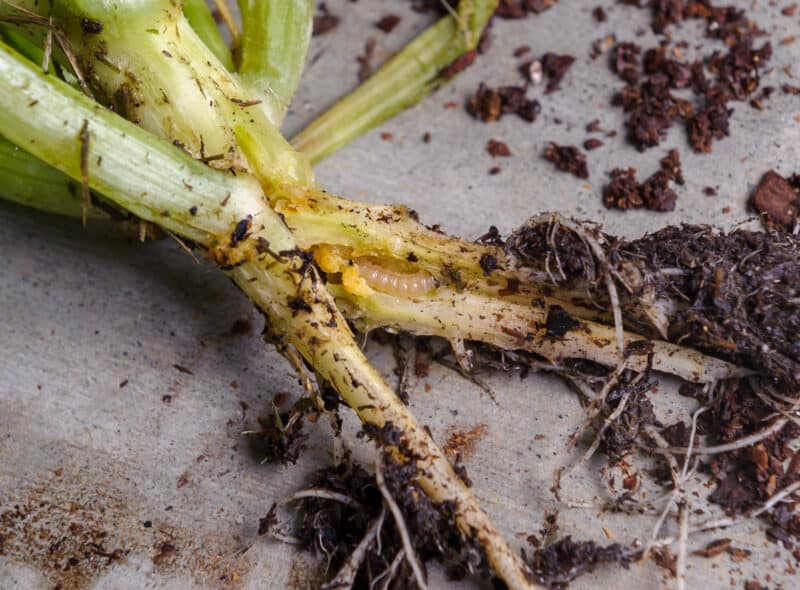
Adult squash vine borers are relatively harmless, it’s their children who are so destructive. Squash borer larvae bore into squash stems to devour them from within. These small, cream-colored caterpillars look like cutworms. After hatching in early summer, the larva will drop to the ground and bore into the base of a squash stem.
Then, it’ll work its way through the plant. As it eats, the larva blocks the flow of nutrients and water from roots to leaves. It’s also devouring healthy squash stem and leaving behind frass.
Frass is a moist, orange, or greenish material. It looks like damp sawdust. It’s essentially what is left behind after the larvae have extracted all the nutrients they can from the vine. If you see frass on or around your squash plants, it’s time to take action.
If left to their own devices, the larvae will feed inside your squash vines for about 6 weeks before burrowing into the ground to pupate. But if you do leave them to eat unchecked, it’ll likely your squash plants will die. Squash vine borers are hungry. Often there are several squash borers in each plant.
Recognizing the Damage
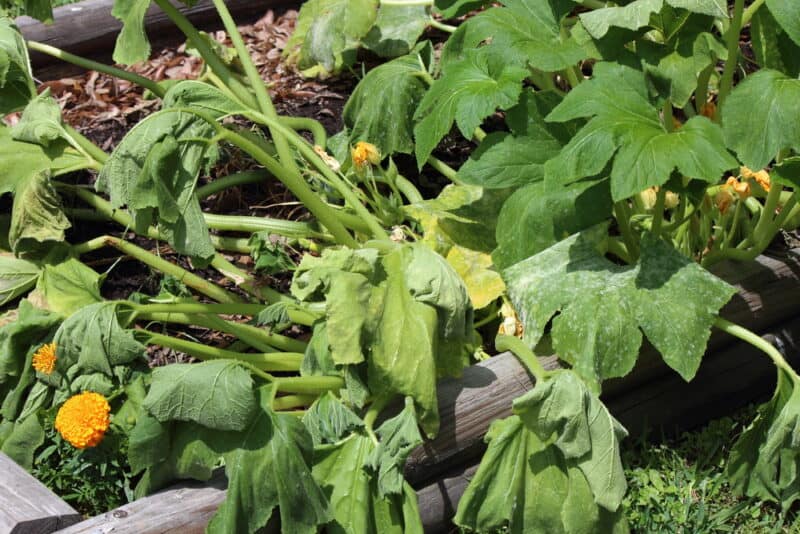
Wilted squash leaves, that don’t perk up when they’re watered is one of the most obvious signs of squash vine borer damage. Unfortunately, if you wait until your squash vines are wilted, it’s unlikely the plants will recover. Instead of waiting for the plants to wilt, be proactive about checking for squash borers.
Hunting for Eggs
Examine your plants often. In early summer, look underneath the leaves and clear away any tiny, reddish-brown eggs you see. Try scraping them gently off the leaf and feeding them to your chickens. If you don’t have chickens, drop the eggs into oil or vinegar and then dispose of them in the trash – not the compost pile.
If you live in one of the warm, southern states, check your squash leaves for eggs consistently. Remember that squash borers can produce two broods in southern states – that means they have two chances to destroy your harvest.
Chasing Caterpillars
Once the larvae have hatched, they’re a little more challenging to find. Because squash vine borers bore into the squash vines right after they’ve hatched, they’re mostly hidden from view. But you can find them by inspecting the base of the squash plant for frass.
Occasionally, you’ll also find frass seeping through cracks in the vine as well. If you see frass seeping out, make a vertical slice in the stem, just above the grass, and remove any larvae you find with your hands or tweezers. The plant can heal a clean, vertical slice once the pests are out of the way.
Feed the caterpillars to your chickens or down them in a jar of water.
Controlling A Squash Vine Borer Infestation
Once squash borer larvae have finished off your squash vines, they’ll delve into the soil to sleep all winter – emerging as creepy, waspy moths in the spring. Then, they’ll raise up a whole new generation of greedy caterpillars right in your garden.
This is unacceptable. Even if you can’t save this year’s squash harvest, don’t allow a new generation of squash borers to kill next year’s harvest as well. Remove the spent vines immediately and burn them. This way, the larvae in the vines never have a chance to pupate in the soil.
Once the season is over, till up the soil completely and leave the squash borer larvae exposed for the birds to feed on.
Preventing A New Infestation
The birds won’t devour all those pupating larvae. In the spring, you’ll hear the buzzing of newly emerged squash vine borer adults. Unlike most moths, squash vine borers fly throughout the day. But like most moths, they have a dangerous attraction to the color yellow.
But while their nighttime cousins are flying perilously close to yellow flames, squash vine borers usually hover around yellow flowers. If you see them flying through the garden, fill a bowl with water (dyed yellow with food coloring) and leave it in the garden. Squash borer adults will be drawn to it and drown themselves in the water.
Covering the Rows
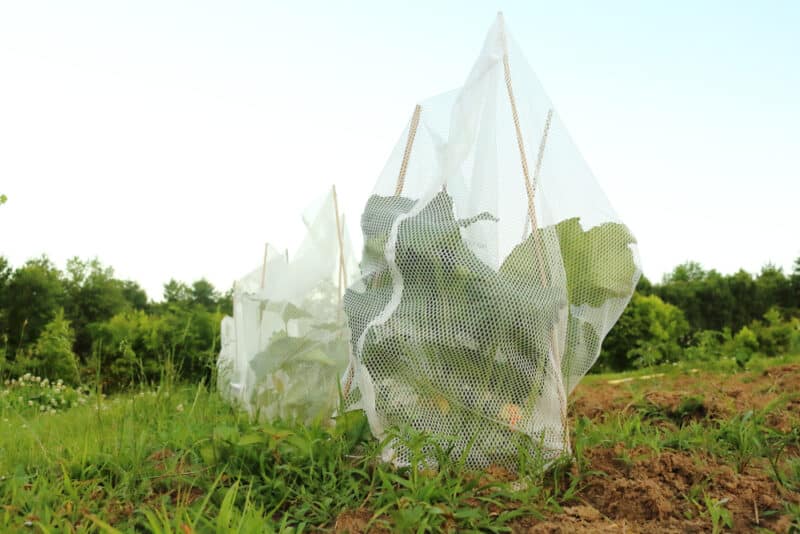
Before the squash borers have time to lay their eggs, as soon as you plant the squashes, cover them with floating row covers. Keep the barriers in place for at least two weeks after the first squash borer adult is seen in the garden.
Make sure that there is no way for adult squash borers can crawl under the row covers and make certain not to plant squash plants in the same location where last year’s squashes grew. If you plant in the same area, adult squash borers could emerge under the row cover and live out their destructive lives in safety.
What about Pesticides?
If you’re interested in using conventional pesticides, apply them at the base of each plant. You should make one application when the first adult squash borers are seen in the garden. Then repeat the application about 10 days later. If squash vine borers are a growing problem in your garden, try repeat applications every 10 days for the first two months of the growing season.
Look for pesticides that include carbaryl, permethrin, bifenthrin, or esfenvalerate to successfully control M. cucurbitae adults and larvae.
But remember, while choosing to use conventional pesticides, to keep pets and children away from recently treated plants. Avoid using more than absolutely necessary to contain the infestation and try to keep your treated rows covered to keep bees and other beneficial insects safe.
